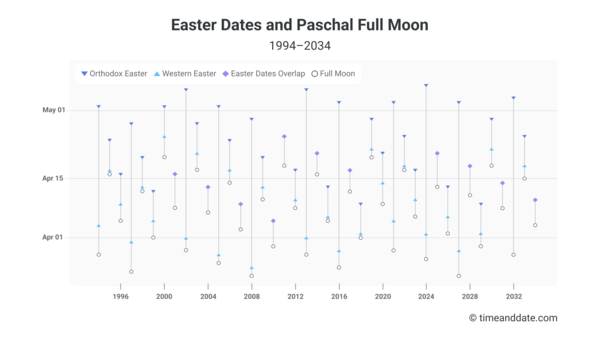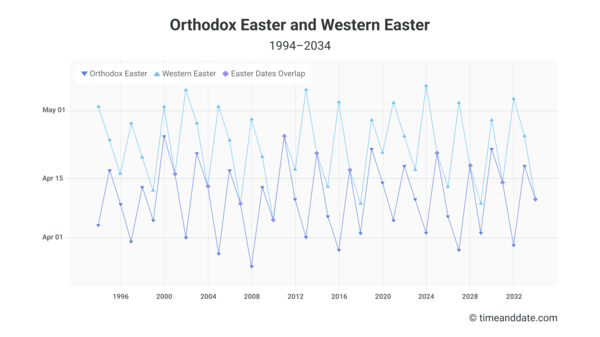Why Is Easter 35 Days Late?
Did you know that there are two Easter dates? One date is 35 days late this year. The reasons are lunar cycles and calendar computations.

Western Easter dates are based on the Gregorian calendar, eastern Easter dates on the Julian calendar.
© iStockphoto.com/DNY59
When Is Easter?
Easter 2024 is Sunday, March 31. Easter is also on Sunday, May 5, a difference of five weeks or 35 days. How can this be true?
There are two dates for Easter: Western Christian churches, such as the Roman Catholic Church, celebrate Easter Sunday on March 31, 2024; Eastern churches, like the Greek Orthodox Church, celebrate Orthodox Easter on May 5, 2024. Both holidays celebrate the resurrection of Jesus Christ and both are the most important holiday for each church.
If both holidays are the same, why are they 35 days apart? Because they use different calendars: Western churches calculate their Easter date based on the Gregorian calendar, while Eastern churches use the Julian calendar.
Why Is the Orthodox Easter So Late?
The Julian calendar is currently 13 days behind the Gregorian calendar. Since the Orthodox Christian churches use the Julian calendar to calculate Easter, it would only be logical to assume that eastern Easter is 13 days behind the western Easter—both calendars are in sync and both holidays are on a Sunday.
In reality, the two Easter dates are never 13 days apart. They vary between 7 days, 28 days, 35 days, and even 0 days; yes, in some years, both Easters become one. Welcome to calendar mathematics.


Our analysis of the timeanddate.com holiday and astronomical data shows the varying differences between Easter dates relating to the Moon phase.
© timeanddate.com / Georg Rehberger
Julian Calendar Drifts Away
The main reason the Catholic Church replaced the Julian calendar in 1582 was that it drifted out of sync with the seasons. Astronomical dates like solstices and equinoxes were off by several days; the ecclesiastical Full Moon drifts away from the true Full Moon by more than three days every millennium.
Is the Julian calendar still in use?
Since the Eastern churches still use the Julian calendar to define their holidays, the date of the Paschal Moon in that calendar, and thus their Easter date, is offset by a week about 44% of the time. Both dates coincide and create one Easter for west and east in about 30% of cases. The rest is either four or five weeks off; this happens when the Gregorian Paschal Moon happens before March 21 in the Julian calendar, causing the Orthodox date to jump ahead to the next Full Moon.


The graph shows the offset between Western and Eastern Easter dates, and their intersection, resulting in the same Easter date every few years.
© timeanddate.com / Georg Rehberger
Computing the Error: Calendar Problems
Easter celebrates re-birth and is thus connected to spring, when the Earth re-awakens after the winter months. The early Christian Church tied its holiest day to the first Full Moon of spring to start its ecclesiastical calendar. For the first couple of hundred years, the Christian Church would announce the Easter date every year. This process was replaced by calculating the date in advance; and since Easter was still tied to the first Full Moon of spring, it was dependent both on lunar cycles and on the solar year to match the season of spring.
The calculation of Easter, the computus, was a massive undertaking. The calculation had to overcome complications with shifting lunar cycles and incorrect oversimplifications of leap days and leap years. The Gregorian calendar was the latest in a sequence of reforms to get the Easter date “back on track.”
There are still many proposals underway to fix computational errors, and different churches have their own preferences for methods and calendars. This means we will likely continue to see two different Easter dates for some time.